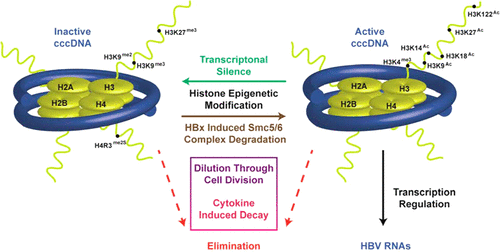当前位置:
X-MOL 学术
›
ACS Infect. Dis.
›
论文详情
Our official English website, www.x-mol.net, welcomes your
feedback! (Note: you will need to create a separate account there.)
Virological Basis for the Cure of Chronic Hepatitis B.
ACS Infectious Diseases ( IF 4.0 ) Pub Date : 2018-06-25 , DOI: 10.1021/acsinfecdis.8b00081 Jin Hu 1, 2 , Junjun Cheng 1 , Liudi Tang 3 , Zhanying Hu 1 , Yue Luo 1, 4 , Yuhuan Li 2 , Tianlun Zhou 1 , Jinhong Chang 1 , Ju-Tao Guo 1
ACS Infectious Diseases ( IF 4.0 ) Pub Date : 2018-06-25 , DOI: 10.1021/acsinfecdis.8b00081 Jin Hu 1, 2 , Junjun Cheng 1 , Liudi Tang 3 , Zhanying Hu 1 , Yue Luo 1, 4 , Yuhuan Li 2 , Tianlun Zhou 1 , Jinhong Chang 1 , Ju-Tao Guo 1
Affiliation

|
Hepatitis B virus (HBV) has infected one-third of world population, and 240 million people are chronic carriers, to whom a curative therapy is still not available. Similar to other viruses, persistent HBV infection relies on the virus to exploit host cell functions to support its replication and efficiently evade host innate and adaptive antiviral immunity. Understanding HBV replication and concomitant host cell interactions is thus instrumental for development of therapeutics to disrupt the virus-host interactions critical for its persistence and cure chronic hepatitis B. Although the currently available cell culture systems of HBV infection are refractory to genome-wide high throughput screening of key host cellular factors essential for and/or regulating HBV replication, classic one-gene (or pathway)-at-a-time studies in the last several decades have already revealed many aspects of HBV-host interactions. An overview of the landscape of HBV-hepatocyte interaction indicates that, in addition to more tightly suppressing viral replication by directly targeting viral proteins, disruption of key viral-host cell interactions to eliminate or inactivate the covalently closed circular (ccc) DNA, the most stable HBV replication intermediate that exists as an episomal minichromosome in the nucleus of infected hepatocyte, is essential to achieve a functional cure of chronic hepatitis B. Moreover, therapeutic targeting of integrated HBV DNA and their transcripts may also be required to induce hepatitis B virus surface antigen (HBsAg) seroclearance and prevent liver carcinogenesis.
中文翻译:

慢性乙型肝炎治愈的病毒学基础。
乙型肝炎病毒(HBV)感染了世界三分之一的人口,2.4亿人是慢性携带者,目前尚无治愈方法。与其他病毒类似,持久性HBV感染依靠该病毒利用宿主细胞功能来支持其复制并有效逃避宿主先天和适应性抗病毒免疫。因此,了解HBV复制和伴随的宿主细胞相互作用有助于开发治疗药物,以破坏对其持久性和治疗慢性乙型肝炎至关重要的病毒-宿主相互作用。尽管目前可用的HBV感染细胞培养系统对全基因组高通量是难治的筛选对于和/或调节HBV复制必不可少的关键宿主细胞因子,在过去的几十年中,一次经典的单基因(或途径)研究已经揭示了HBV-宿主相互作用的许多方面。HBV-肝细胞相互作用的概况概述表明,除了通过直接靶向病毒蛋白来更紧密地抑制病毒复制外,破坏关键的病毒-宿主细胞相互作用以消除或灭活共价闭合的环状(ccc)DNA最为重要。稳定的HBV复制中间体(作为游离的微小染色体存在于被感染的肝细胞核中)对于实现慢性乙型肝炎的功能治愈至关重要。此外,可能还需要对整合的HBV DNA及其转录本进行治疗性靶向以诱导乙型肝炎病毒表面抗原(HBsAg)血清清除并防止肝癌发生。
更新日期:2018-06-12
中文翻译:

慢性乙型肝炎治愈的病毒学基础。
乙型肝炎病毒(HBV)感染了世界三分之一的人口,2.4亿人是慢性携带者,目前尚无治愈方法。与其他病毒类似,持久性HBV感染依靠该病毒利用宿主细胞功能来支持其复制并有效逃避宿主先天和适应性抗病毒免疫。因此,了解HBV复制和伴随的宿主细胞相互作用有助于开发治疗药物,以破坏对其持久性和治疗慢性乙型肝炎至关重要的病毒-宿主相互作用。尽管目前可用的HBV感染细胞培养系统对全基因组高通量是难治的筛选对于和/或调节HBV复制必不可少的关键宿主细胞因子,在过去的几十年中,一次经典的单基因(或途径)研究已经揭示了HBV-宿主相互作用的许多方面。HBV-肝细胞相互作用的概况概述表明,除了通过直接靶向病毒蛋白来更紧密地抑制病毒复制外,破坏关键的病毒-宿主细胞相互作用以消除或灭活共价闭合的环状(ccc)DNA最为重要。稳定的HBV复制中间体(作为游离的微小染色体存在于被感染的肝细胞核中)对于实现慢性乙型肝炎的功能治愈至关重要。此外,可能还需要对整合的HBV DNA及其转录本进行治疗性靶向以诱导乙型肝炎病毒表面抗原(HBsAg)血清清除并防止肝癌发生。











































 京公网安备 11010802027423号
京公网安备 11010802027423号